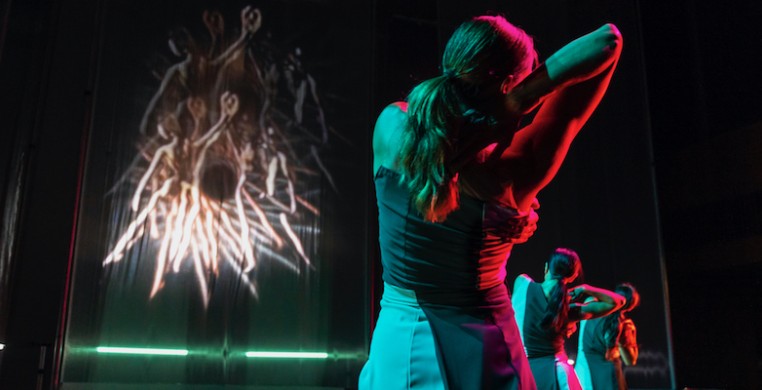The Chicago dance community lost an integral influencer just shy of a year ago when Claire Bataille, a founding member of Hubbard Street Dance Chicago, passed away due to pancreatic cancer. Her enthusiastic performance quality, innovative choreographic ideas, and inspirational teaching methods all embody what Bataille contributed to our lives as artists. The loss is still felt throughout the city; however, Robyn Mineko William’s one-night-only premiere of “Echo Mine” at the Harris Theater is a tribute that reminds us all about the beautiful, creative, and complex life Bataille lived.
The performers—current Hubbard Street dancer Jacqueline Burnett, former Hubbard Street dancer Meredith Dincolo, and Mineko Williams—are the embodiment of long-limbed lines and sound-to-body personification. Together the trio glided around the stage with an ease only achievable through hours spent together in the studio. The choreography was true to Mineko Williams’ style, filled with quirky accents and repetitive movement patterns. Her usage of striking gestural motifs allows for easy tracking of the dance as audience members, and the exquisite technique is recognizable to any trained eye. She has created a piece that transcends the common ideology that all dances are too long.
The collaboration of artistic minds is easily recognized and appreciated in the opening image alone. The scenic design directs one’s mind to the inner workings of a dance studio through the use of a singular, horizontal bar of white neon light housed upstage for the entirety of the performance. It’s a trigger to any person who’s spent hours of their youth doing pliés at a ballet barre. A silhouetted dancer and an empty chair are the foreground for the stirring projection of a young Bataille twirling her way through a performance, so carefully manipulated to play both forward and in reverse. The moment the lights fade in, we see the angularly stylized, block patterned dresses in both light and dark grey tones that bring to mind an essence of longing and remembrance. With Eric Southern as lighting designer, CandyStations as scenic and projective designer, and Hogan McLaughlin as costume designer, the subtlety and brilliance found in every compositional aspect of “Echo Mine” doesn’t go unnoticed.
The piece progresses in the manner a music album develops. In the way each song has its own message, its own directive rhythm or defining style, each dance segment has its own definitive movement quality and emotional inspiration. From song to song, from dance to dance, Mineko Williams blends her choreographic identity harmoniously with Chicago native, experimental-rock band, Califone’s, identity. The group composed the original score specifically for this evening’s work, and from track to track, the haunting ambient tones and raw angsty vocals held attention with an equal intensity alongside the lengthy bodies executing the weightless movement onstage.
The piece was made in collaboration with Bataille throughout her final years, yet it doesn’t seem as though this work is simply a tribute to her individual life. Yes, we hear snippets of her talking about finding strength in being a dancer through her chemotherapy, but the piece also evokes something of an emotional tribute to the life of a dancer. In various moments we see the evolution of Bataille’s career projected on the screen behind the dancers, and as we watch her age, we see each dancer portray Bataille as a performer, as a choreographer, and as a teacher. In parallel to a video of Claire running a rehearsal seated in a chair, we watch live as Dincolo flourishes a leg cross while seated in the same chair onstage. As we watch footage of a performing Bataille, we catch Burnett executing similarly gorgeous extensions and turns. And in the climactic instance of internal struggle, we see Burnett and Mineko Williams physicalize the pain of grappling with the end of youth and dance in one’s life, complete with the highlight of an intense spotlight.
In the end, the imperfectly explained movement motifs become so perfectly described as the finale of “Echo Mine” is stunning footage of Bataille executing a large portion of the choreography the audience just spent the evening observing. With three chairs, three seated dancers, and one projection, we get the privilege of seeing the quartet of dancers one last time moving in disjointed unison. Audible sobs filled the theater, and the evening ended with a standing ovation. Not only applauding the captivating beauty of Robyn Mineko William’s work, but also celebrating the life of a true Chicago dance pioneer.


